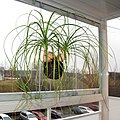Top Qs
Timeline
Chat
Perspective
Beaucarnea recurvata
Species of tree From Wikipedia, the free encyclopedia
Remove ads
Beaucarnea recurvata, the elephant's foot[4] or ponytail palm,[5] is a species of flowering plant in the family Asparagaceae.[6][7] The species is endemic to eastern Mexico; according to IUCN it is now confined to the state of Veracruz,[1] but Plants of the World Online also cites it as occurring in Oaxaca, Puebla, San Luis Potosí, and Tamaulipas.[6][8] Despite its common name, it is not closely related to the true palms (Arecaceae). It has become popular in Europe and worldwide as an ornamental plant. There are 350-year-old Beaucarneas registered in Mexico.[9]
Remove ads
Description
It is an evergreen perennial growing to 8 metres (26 ft) in height, with an enormously expanded caudex for storing water.[10] This caudex can be as great as 14 m (46 ft) girth in the wild.[11][12] The single palm-like stem produces terminal tufts of strap-shaped, recurved leathery leaves, sometimes hair lock-shaped in the ends, and with occasional panicles of small white flowers once the plant reaches over 10 years of age.
The trunk is swollen at the base and slender higher up; young plants are unbranched, but become well branched with age. The almost spherical caudex in the youth stage later becomes broadly conic and very wide at the base. The bark is smooth or finely cracked. The leaves are green, linear, slightly recurved and bent, thin, flat or slightly ridged. They are up to 180 cm (71 in) long and up to 2 cm (0.79 in) wide.[10] The flowers are creamy-white, 1.5 mm diameter, produced in a dense panicle 90–112 cm tall.[10]
Remove ads
Habitat
Beaucarnea recurvata occurs over an altitudinal range of 200 to 900 m above sea level.[1] It grows on rocky soils deficient in nutrients, cliffs and steep mountains, where it grows in full sun or partial shade. Its habitat is low deciduous forest, with average temperatures of 20 °C and an annual rainfall of 800 mm, and a well-marked dry season of between 7 and 8 months. The plants are very slow growing and very tolerant to drought.[13]
Remove ads
Conservation
The species of the genus Beaucarnea are mostly in critical condition due to various anthropogenic activities, which has led to severe fragmentation and destruction of their habitat. Additionally, the collection of seeds, seedlings, juveniles and adults for commercial use has affected population size and the proportion of sexes, thereby reducing fertilization possibilities and, consequently, seed production.[14] This exploitation process exposes this species, in a state of threat or extinction, by reducing the minimum viable size of the populations, as well as the deterioration of their genetic diversity.[15] Beaucarnea recurvata, is considered to be threatened according to Official Mexican Standard 059-ECOL-2010 of SEMARNAT in Mexico.
The species is listed in Appendix II of the Convention on International Trade in Endangered Species (CITES) meaning international trade in the species and its parts/derivatives is regulated by the CITES permitting system.[2]
Cultivation
Having gained the Royal Horticultural Society's Award of Garden Merit,[4] B. recurvata is often grown as a houseplant, or an outdoor plant in subtropical climate gardens. Slow-growing and drought-tolerant, Beaucarnea recurvata is hardy to 10 °C (50 °F), grows in full sun to light shade, and requires proper soil mix to drain when watered. However, be cautious not to over-water, as this will foster pests like the mealybug and cochineal insect. If going to be kept in places with winter frost, it must be an indoor plant as it cannot resist cold temperatures. To maintain its original shape, the ends of its leaves should not be snipped, and when repotted it must keep all of its roots.[15]
Remove ads
Toxicity
The species is not toxic to dogs, cats or horses.[16]
Gallery
- In flower, Llera de Canales, Tamaulipas
- Cultivated, Madeira garden
- Regrowth after a crown breakage on a cultivated plant in Homestead, Florida
- Macro image of the serrated margin of a leaf from a 7-year-old potted plant.
References
External links
Wikiwand - on
Seamless Wikipedia browsing. On steroids.
Remove ads








